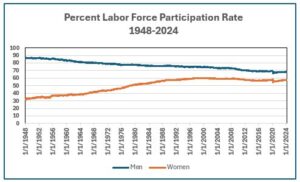Return-to-Office Mandates
After World War II ended, the nation’s labor force returned to civilian life. By the end of 1945 more than four million soldiers returned to civilian status. More than six million women held wartime jobs in factories and three million volunteered with the Red Cross. Government archives reporting on women in the labor force during World War II reported on the aftermath: “After the war, most women returned home, let go from their jobs. Their jobs, again, belonged to men. However, there were lasting effects. Women had proven that they could do the job and within a few decades, women in the workforce became a common sight.”
At the beginning of 1948 the post-war pattern of families with working fathers and homemaker mothers was well established. The labor force participation rate for men aged 16-64 was 87 percent, and for women, 32 percent. As the chart illustrates, the two rates moved toward converging over the following seven decades. By the start of 2020, the rate for men had fallen to 69 percent, but the rate for women increased to 58 percent. The Covid-19 pandemic of 2020 and its aftermath disrupted employment trends for both men and women.
working fathers and homemaker mothers was well established. The labor force participation rate for men aged 16-64 was 87 percent, and for women, 32 percent. As the chart illustrates, the two rates moved toward converging over the following seven decades. By the start of 2020, the rate for men had fallen to 69 percent, but the rate for women increased to 58 percent. The Covid-19 pandemic of 2020 and its aftermath disrupted employment trends for both men and women.
Between February and April of 2020 the United States lost over 22 million jobs. The first months of job recovery saw females returning at a slower pace than males, but when the opportunity for remote work became common, it is credited with fueling a record rate of female labor force participation. A study by the San Francisco Federal Reserve found that participation changed for different subsets of the female labor force: “…women without a college degree disproportionately dropped out of the labor force during the pandemic, perhaps to care for children or sick relatives. However, we find that women with a college degree or more increasingly joined the labor force during this period, potentially because of more opportunities to work from home.”
Now Return-to-Office (RTO) mandates are threatening to erase the gains. While a recent survey by McKinsey found that nine out of ten women want to work remotely all or part of the time, a global survey found that almost two-thirds of CEOs expect employees to return to offices five days a week by 2026.
The appeal of remote working is shared by male and female workers alike, both part-time and full-time, according to various surveys. Businesses have contrasting views on the benefits of office-only work: while some see higher productivity when people work from home, others stress the advantages of in-person collaboration. Examples abound of workers planning to quit if given an RTO mandate, and of workers willing to accept less pay for a remote work opportunity. All this is occurring in a demographic environment of fewer births, an aging population, and a smaller work force.
